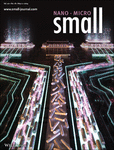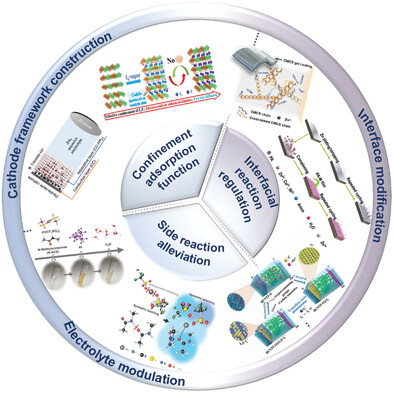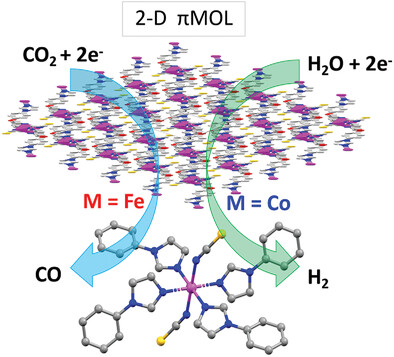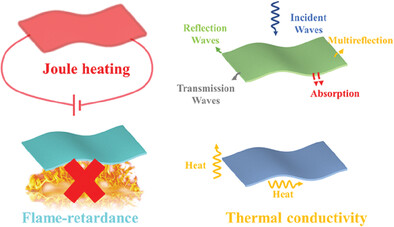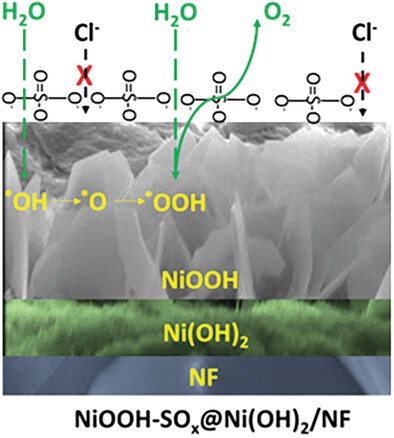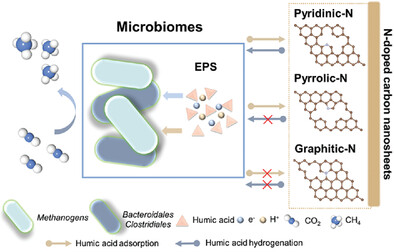Journal list menu
Export Citations
Download PDFs
Cover Picture
On-Demand Tunable Electrical Conductance Anisotropy in a MOF-Polymer Composite (Small 18/2024)
- First Published: 02 May 2024
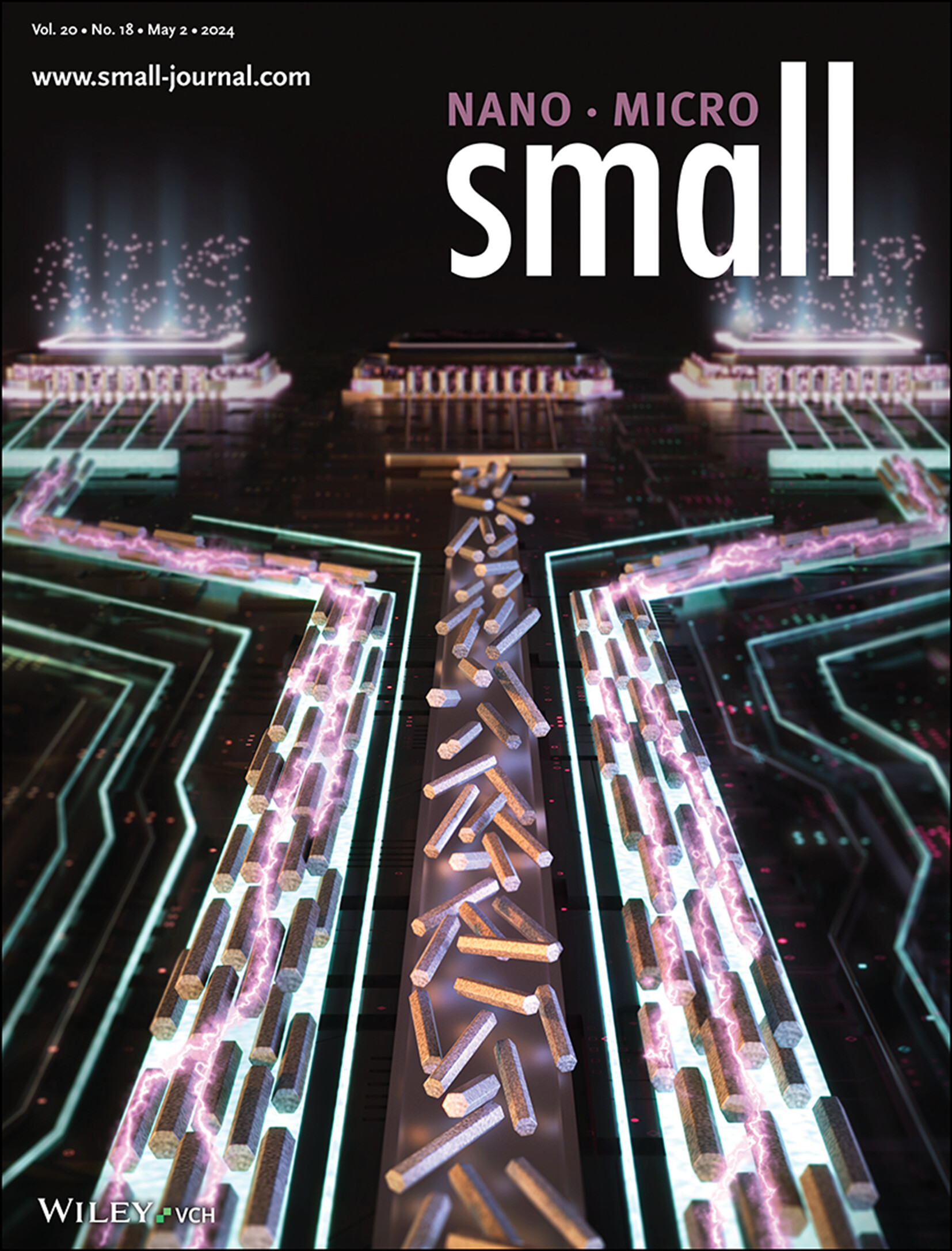
Metal–Organic Frameworks
The post-synthetic alignment of conductive Cu3(HHTP)2 crystals by an electric field is used for the on-demand pattern generation and to obtain a composite material exhibiting an anisotropic conductivity. The crystals' precise orientational and positional control and subsequent modulation of the bulk electrical properties are crucial for designing microelectronics and chemiresistive sensors based on conductive metal–organic frameworks. More in article number 2309469, Dong Ki Yoon, Jesse G. Park, and co-workers.
Inside Front Cover
Maximizing Photoelectrochemical Performance in Metal-Oxide Hybrid Composites via Amorphous Exsolution—A New Exsolution Mechanism for Heterogeneous Catalysis (Small 18/2024)
- First Published: 02 May 2024
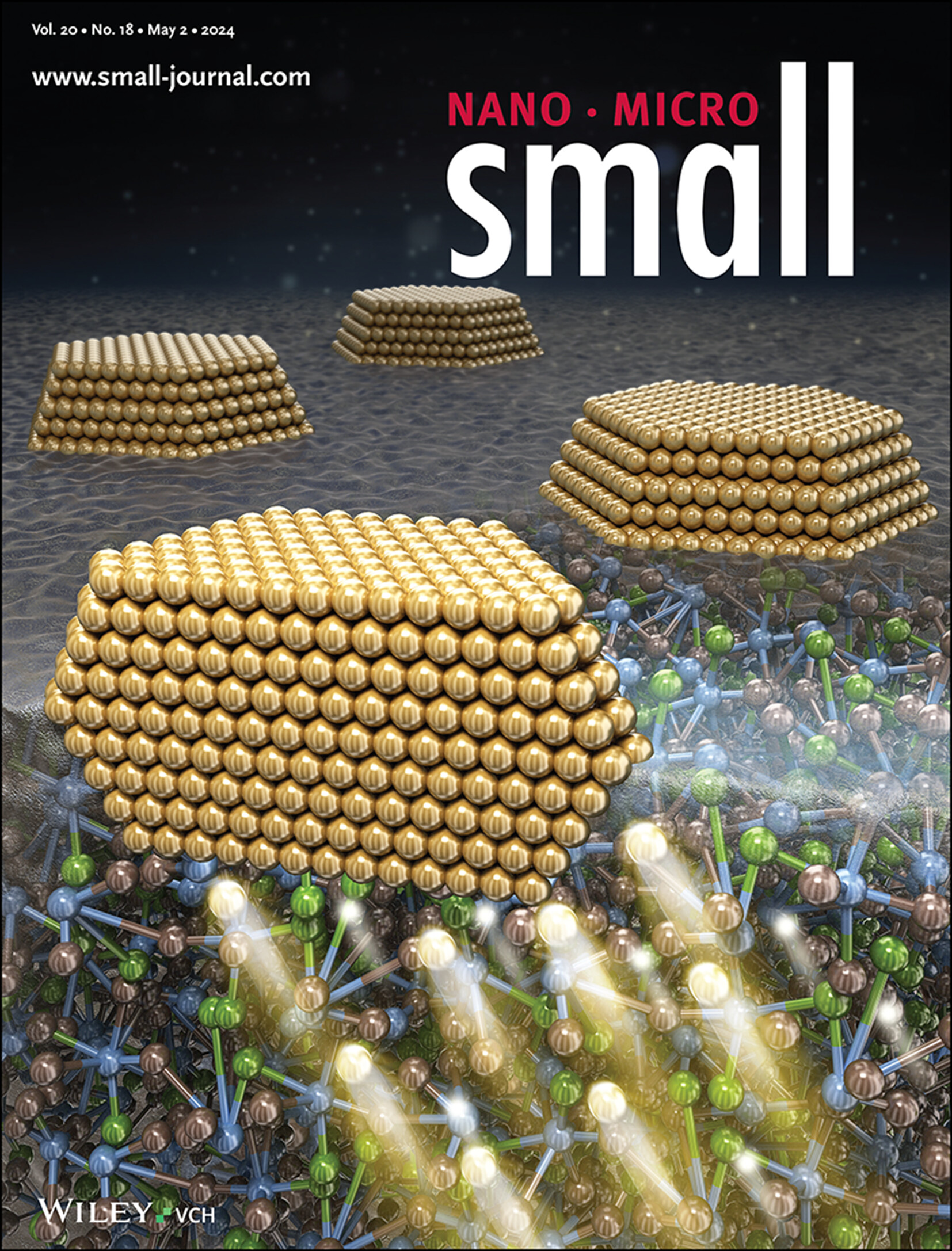
Heterogeneous Catalysis
In article number 2308934, Bong-Joong Kim and co-workers devise a method to exsolve metal dopants from amorphous perovskite oxides, followed by the crystallization of these oxides through vacuum-annealing at elevated temperatures. This process extracts all heavily doped Co atoms from SrTiO3, resulting in uniformly distributed, high-density CoO nanoparticles embedded in the oxide support, providing structural stability, and enhancing photoelectrochemical performance.
Inside Back Cover
Small Warriors of Nature: Novel Red Emissive Chlorophyllin Carbon Dots Harnessing Fenton-Fueled Ferroptosis for In Vitro and In Vivo Cancer Treatment (Small 18/2024)
- First Published: 02 May 2024
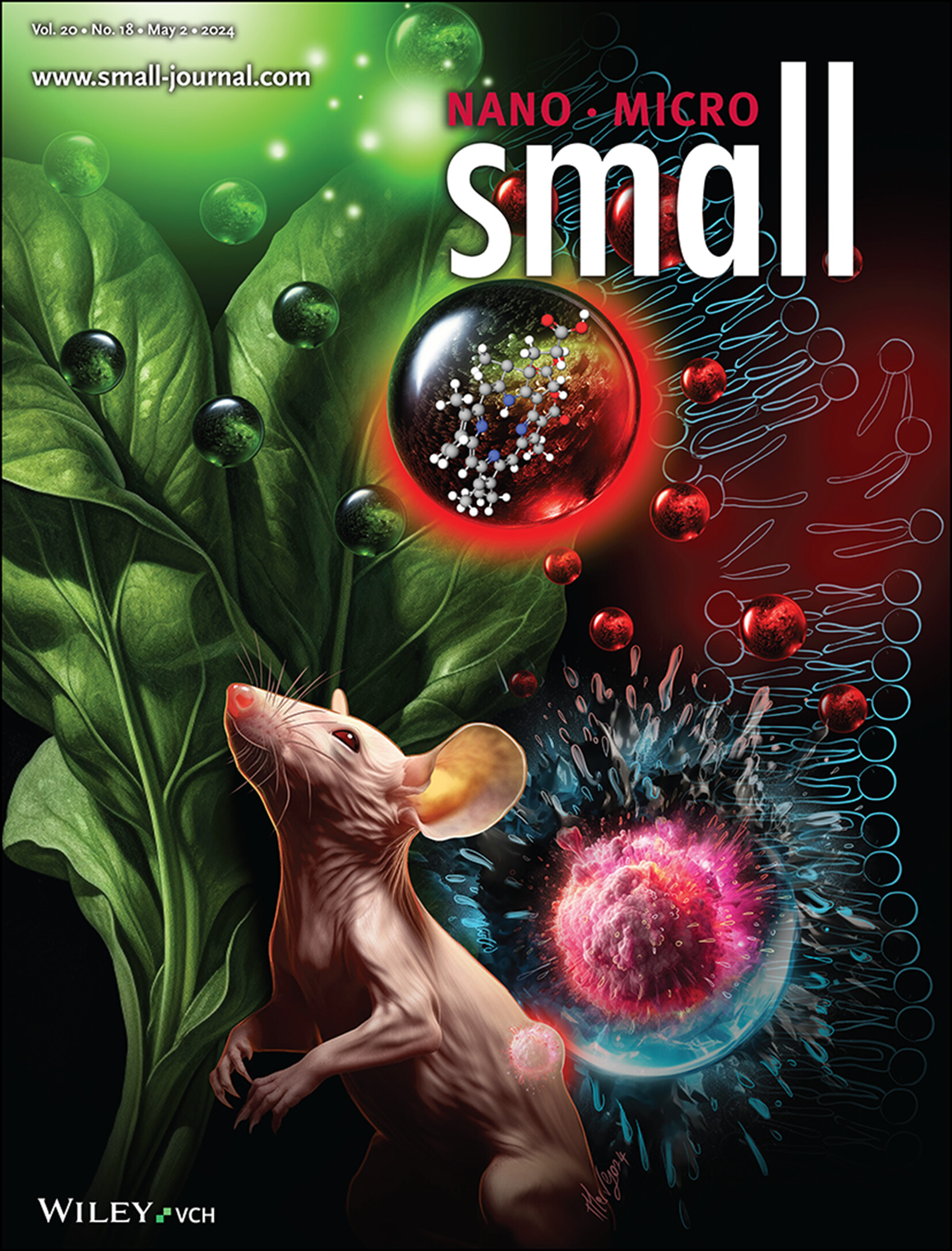
Cancer Treatments
In article number 2309283, Emel Kirbas Cilingir, Açelya Yilmazer, Roger M. Leblanc, and co-workers discuss the synthesis of copper chlorophyllin-based carbon dots (Chl-D CDs) that exhibit unique spectroscopic traits. These dots induce a Fenton-like reaction, enhancing photodynamic therapy efficacy through ferroptotic and apoptotic pathways. The study explores their biocompatibility and potential in cancer treatment, highlighting their role in reactive oxygen species formation and the modulation of oxidative stress.
Back Cover
Protective Topical Dual-Sided Nanofibrous Hemostatic Dressing Using Mussel and Silk Proteins with Multifunctionality of Hemostasis and Anti-Bacterial Infiltration (Small 18/2024)
- First Published: 02 May 2024
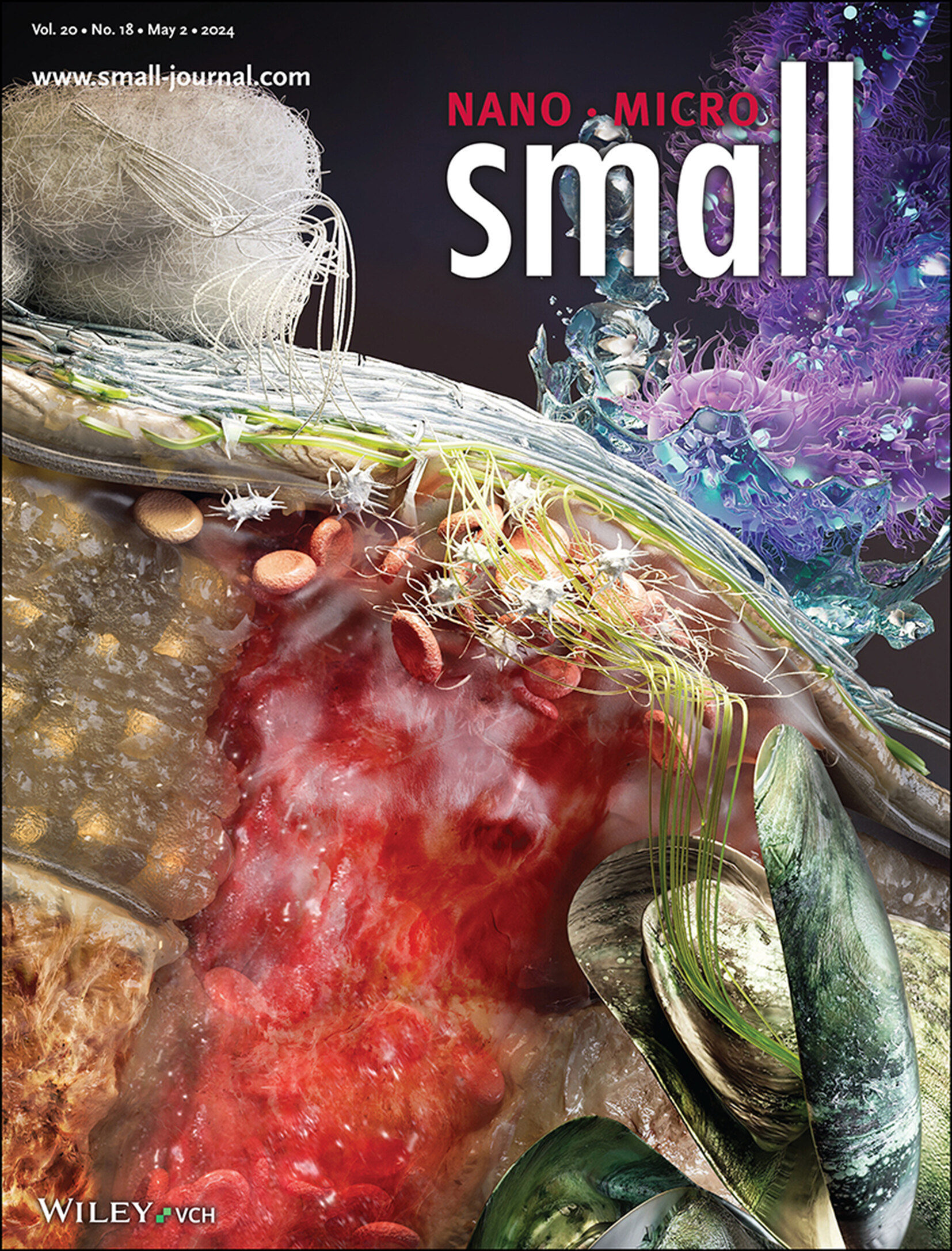
Nanofibrous Hemostatic Dressings
In article number 2308833, Kye Il Joo, Hyung Joon Cha, and co-workers developed a protein-based nanofibrous hemostatic dressing for the treatment of internal bleeding. Mussel adhesive protein was first introduced as a hemostatic agent, and its effect on blood coagulation was confirmed at the inner layer of the dressing. Silk fibroin, consisting of the outer layer of the dressing, was controlled through changes in its secondary structure, which protects the wound site from contamination and infection.
Masthead
Comments
Comment on “An Injectable Hydrogel to Modulate T Cells for Cancer Immunotherapy”
- First Published: 10 December 2023
Reviews
Heterogeneous Catalysis in Production and Utilization of Formic Acid for Renewable Energy
- First Published: 10 December 2023
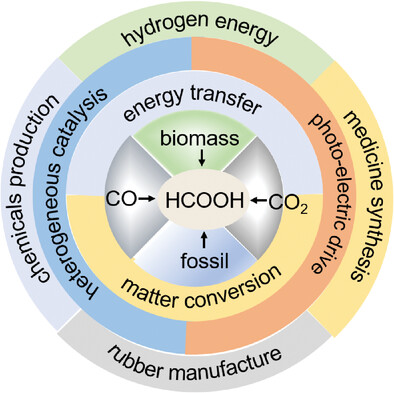
This review concentrates on the matter and energy conversion between carbon dioxide and formic acid. The production and utilization of formic acid, the catalytic mechanism, and the challenge and future prospects are comprehensively summarized. The development of hydrogen economy and environmental protection will be realized simultaneously.
Targeting Diverse Wounds and Scars: Recent Innovative Bio-design of Microneedle Patch for Comprehensive Management
- First Published: 01 December 2023
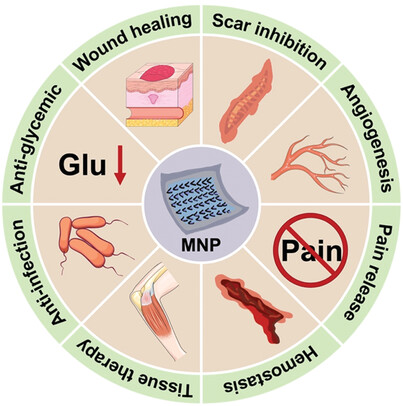
This work surveys various microneedle patches applied in recent years targeting diverse wounds and scars, exploring the potential to improve specific types of wound healing and mitigate pathological scarring. The therapeutic efficacy, management of related symptoms, side effects, materials, and manufacturing methods are assessed, providing insights into future research and clinical translation.
3D Covalent Organic Frameworks from Design, Synthesis to Applications in Optoelectronics
- First Published: 06 December 2023
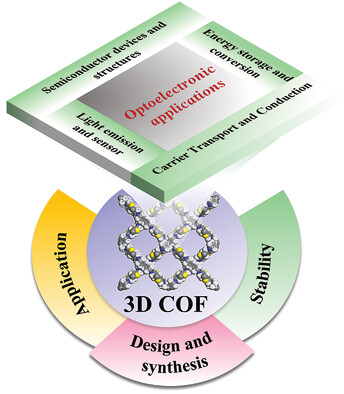
This progress focuses on the study of three-dimensional (3D) COFs, introducing the design principles, synthesis methods, strategies to improve the stability and functionalization of 3D COFs. The focus is on the applications of 3D COFs in electronics, summarizing the applications of 3D COFs in light emission, fluorescence sensing and detection, energy storage and conversion, electronic conduction and carrier transport.
Recent Research on Preparation and Application of Smart Joule Heating Fabrics
- First Published: 10 December 2023
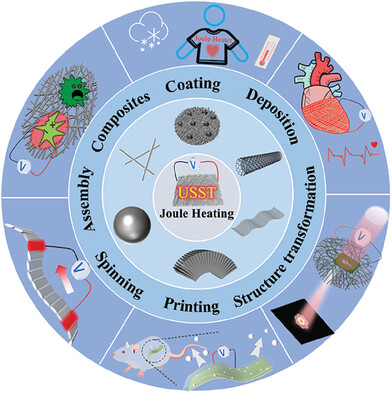
This is a comprehensive overview of smart Joule-heated fabrics. This review focuses on the conductive materials currently used for smart Joule heating, the strategies for the preparation of smart Joule heating fabrics, and the latest applications of smart Joule heating fabrics in the areas of personal thermal management, health therapy, visual indication, drug release, and soft actuators.
Aqueous Rechargeable Zn–Iodine Batteries: Issues, Strategies and Perspectives
- First Published: 10 December 2023
Frontispiece
Low-temperature Ruby Crystal Growth Via a Supersaturation Process Based on Flux Decomposition (Small 18/2024)
- First Published: 02 May 2024
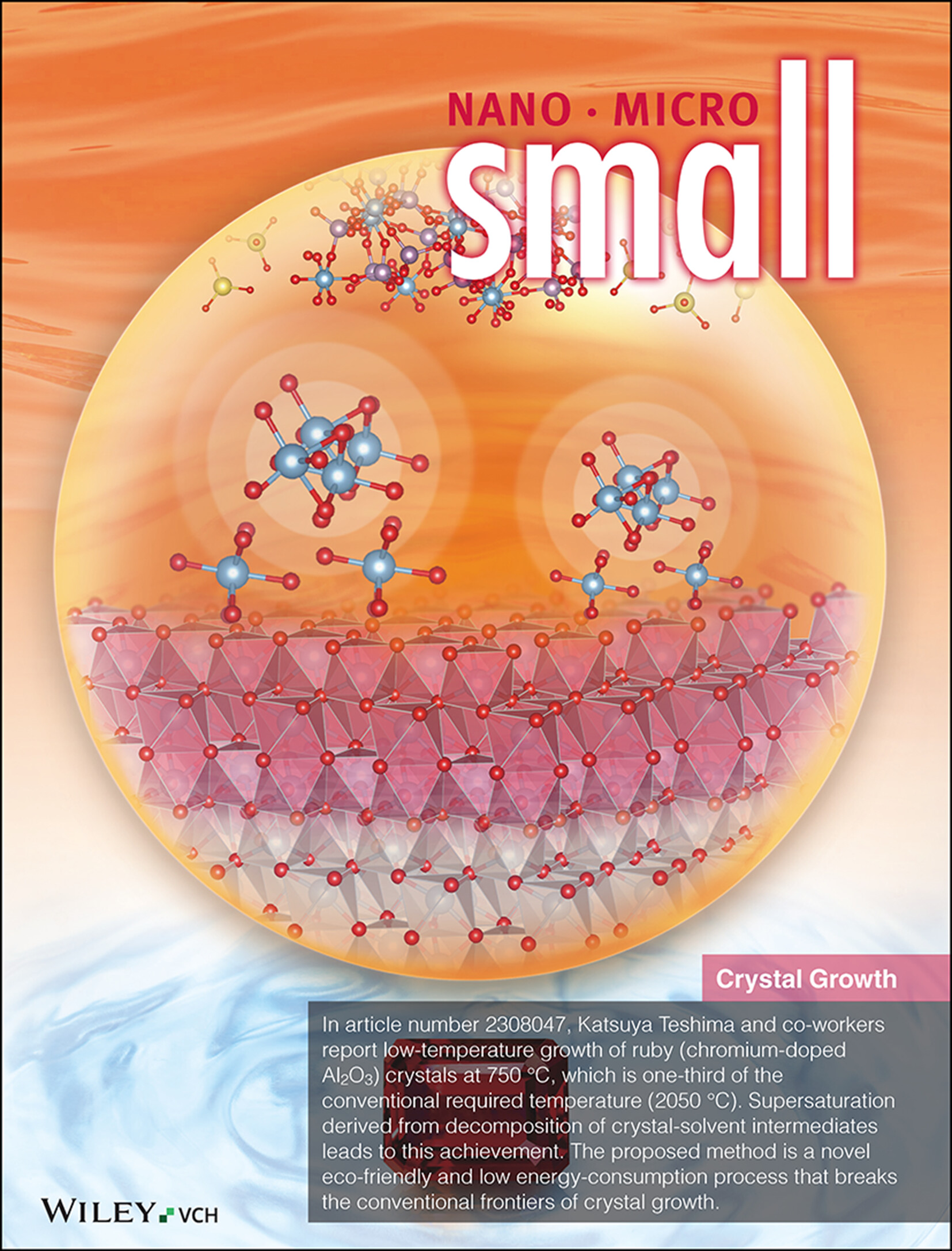
Crystal Growth
In article number 2308047, Katsuya Teshima and co-workers report low-temperature growth of ruby (chromium-doped Al2O3) crystals at 750 °C, which is one-third of the conventional required temperature (2050 °C). Supersaturation derived from decomposition of crystal-solvent intermediates leads to this achievement. The proposed method is a novel eco-friendly and low energy-consumption process that breaks the conventional frontiers of crystal growth.
Research Articles
Low-temperature Ruby Crystal Growth Via a Supersaturation Process Based on Flux Decomposition
- First Published: 02 January 2024
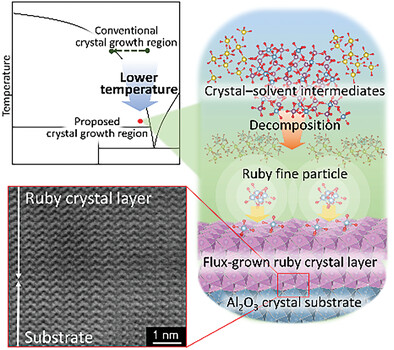
This article represents the first report on the low-temperature growth of ruby (chromium-doped Al2O3) crystals at 750 °C, which is one-third of the conventional required temperature (2050 °C). Supersaturation based on the de-composition of crystal–solvent intermediates enables crystal growth at low temperatures.
Frontispiece
Creation of High-Quality Deep-Blue AIE Emitter with a Crossed Long-Short Axis Structure for Efficient and Versatile OLEDs (Small 18/2024)
- First Published: 02 May 2024
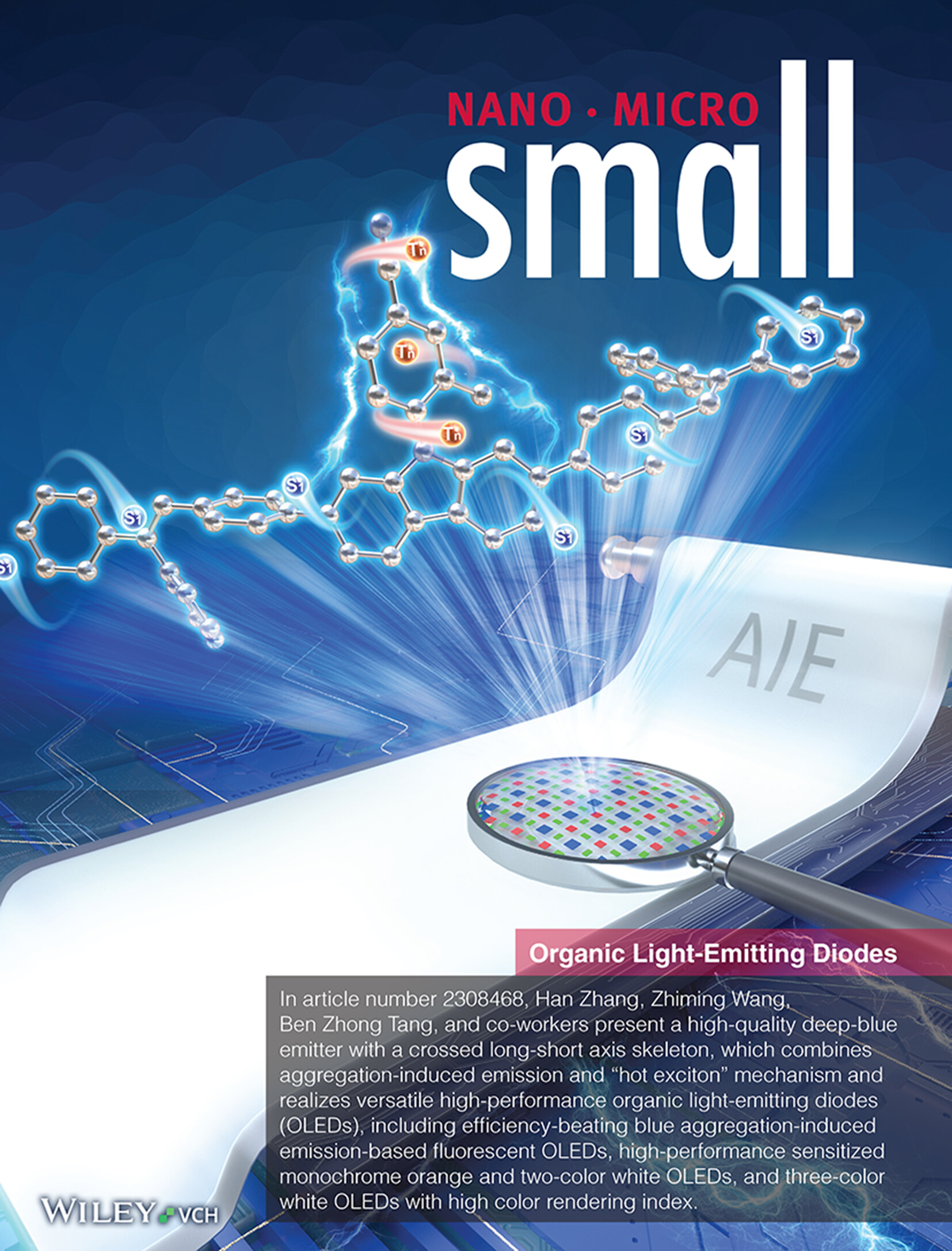
Organic Light-Emitting Diodes
In article number 2308468, Han Zhang, Zhiming Wang, Ben Zhong Tang, and co-workers present a high-quality deep-blue emitter with a crossed long-short axis skeleton, which combines aggregation-induced emission and “hot exciton” mechanism and realizes versatile high-performance organic light-emitting diodes (OLEDs), including efficiency-beating blue aggregation-induced emission-based fluorescent OLEDs, high-performance sensitized monochrome orange and two-color white OLEDs, and three-color white OLEDs with high color rendering index.
Research Articles
Creation of High-Quality Deep-Blue AIE Emitter with a Crossed Long-Short Axis Structure for Efficient and Versatile OLEDs
- First Published: 27 November 2023
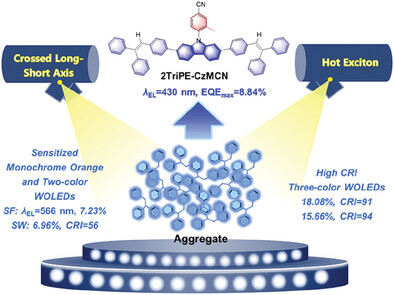
Based on crossed long-short axis molecule design, a high-quality deep-blue emitter with combined aggregation-induced emission and “hot exciton” mechanism is reported, which realized efficiency-beating blue AIE-based fluorescent OLEDs, high-performance sensitized monochrome orange and two-color white OLEDs, and three-color white OLEDs with high color rendering index.
On-Demand Tunable Electrical Conductance Anisotropy in a MOF-Polymer Composite
- First Published: 04 January 2024
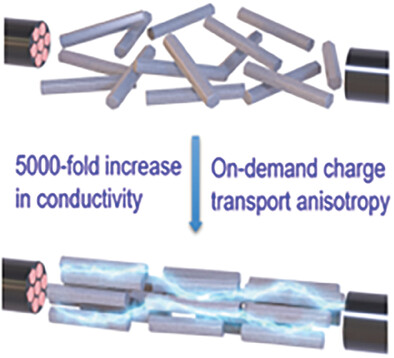
Using E-field, the alignment of conductive Cu3(HHTP)2 in PEGDA yields a 5000-fold increase in the electrical conductivity of the composite. Despite a low content (≈1 wt.%) of Cu3(HHTP)2, the aligned crystals provide long-range charge transport channels, resulting in a significant conductivity (≈10−3 S cm−1). The technique enables facile patterning, useful for developing electrical interconnects and microelectronics based on porous conductors.
Maximizing Photoelectrochemical Performance in Metal-Oxide Hybrid Composites via Amorphous Exsolution—A New Exsolution Mechanism for Heterogeneous Catalysis
- First Published: 31 December 2023
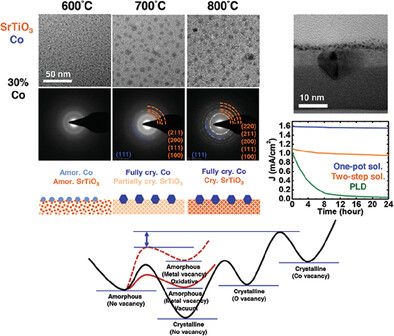
A method is devised to exsolve dopants from the amorphous state of perovskite oxide, followed by crystallization of the oxide through vacuum-annealing at elevated temperatures. This process extracts all Co atoms heavily doped into SrTiO3, resulting in the formation of uniformly distributed high-density CoO particles embedded in the support, with complete structural stability, dramatically enhancing photoelectrochemical (PEC) performances.
Small Warriors of Nature: Novel Red Emissive Chlorophyllin Carbon Dots Harnessing Fenton-Fueled Ferroptosis for In Vitro and In Vivo Cancer Treatment
- First Published: 17 January 2024
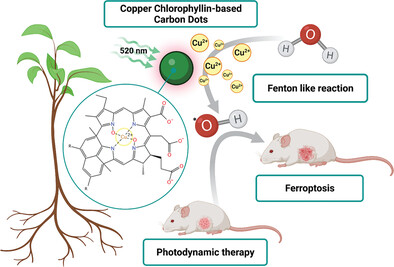
In a groundbreaking development, copper chlorophyllin-based carbon dots (Chl-D CDs) are synthesized, displaying unique red emissive traits, and enhancing photodynamic therapy (PDT) by harnessing Fenton-like reaction. Chl-D CDs' ability to enhance PDT through ferroptotic and apoptotic pathways offers a secure and efficient approach to combined cancer therapy, making them an intriguing topic for exploration.
Protective Topical Dual-Sided Nanofibrous Hemostatic Dressing Using Mussel and Silk Proteins with Multifunctionality of Hemostasis and Anti-Bacterial Infiltration
- First Published: 07 January 2024
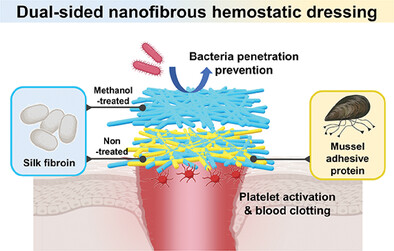
An innovative dual-sided nanofibrous dressing for topical hemostasis is developed using bioengineered mussel adhesive protein and silk fibroin. The wound-adhesive layer significantly reduces bleeding time and blood loss in wounds with hemorrhage, while the anti-adhesive layer acts as a robust physical barrier with enhanced protective qualities against contaminant penetration.
All-Dielectric Integrated Meta-Antenna Operating in 6G Terahertz Communication Window
- First Published: 08 January 2024
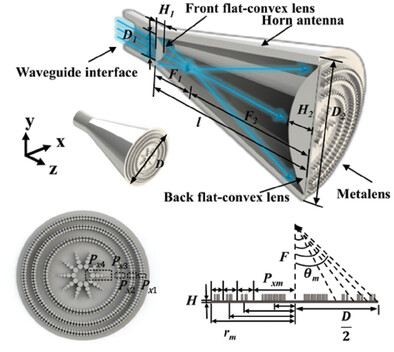
An all-dielectric integrated meta-antenna operating in 6G terahertz communication window is reported for high-efficiency beam focusing in sub-wavelength scale with a long depth of focus. With the antenna surface functionalized by metagrating arrays with asymmetric scattering patterns, the design and optimization methods are demonstrated with a physical size constraint. Its application for integrated imaging and communication is demonstrated.
Low Power Volatile and Nonvolatile Memristive Devices from 1D MoO2-MoS2 Core–Shell Heterostructures for Future Bio-Inspired Computing
- First Published: 27 December 2023
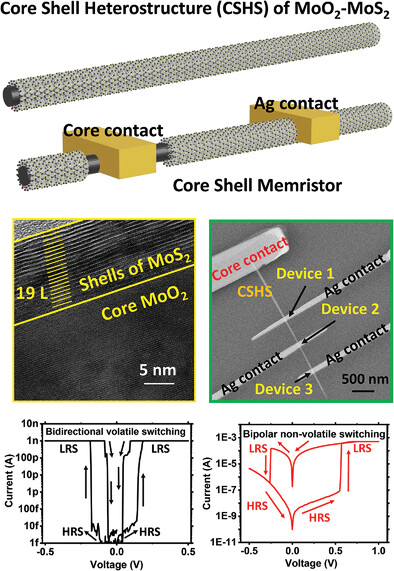
Here, an innovative architecture comprising of 1D CVD-grown core–shell heterostructures (CSHSs) of MoO2-MoS2 is employed as memristors, manifesting both volatile and nonvolatile switching phenomena. These CSHSs offer an unprecedented solution to the interfacial issues between metallic electrodes and the layered materials-based switching element with the prospects of developing smaller footprint memristive devices for future integrated circuits.
Free-Standing Electrode and Fixed Surface Tiny Electrode Implemented Triboelectric Nanogenerator with High Instantaneous Current
- First Published: 04 December 2023

A free-standing electrode and fixed surface tiny electrode implemented triboelectric nanogenerator (FFI-TENG) proposed to be able to generate hundredfold higher instantaneous current compared with conventional single-electrode TENG at an ultra-low working frequency of 0.1 Hz. Furthermore, a series of LEDs lighted by gentle finger touch is verified.
Molten-Salt Electrochemical Preparation of Co2B/MoB2 Heterostructured Nanoclusters for Boosted pH-Universal Hydrogen Evolution
- First Published: 06 December 2023
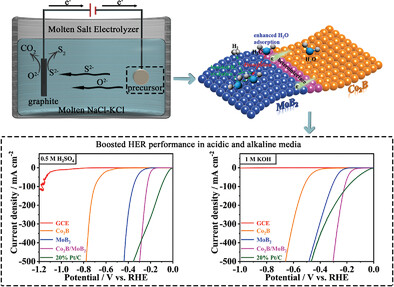
Co2B/MoB2 heterostructured nanoclusters for hydrogen evolution reaction (HER) catalysts are prepared by molten-salt electrolysis (MSE). Charge redistribution at the heterointerface modified the electronic structure and decreased the H adsorption and H2O dissociation-free energies. The synergy at the heterointerface contributes to boost HER intrinsic catalytic activity of Co2B/MoB2 in pH-universal electrolytes.
Editor's Choice
High-Throughput Deposition of Recyclable SnO2 Electrodes toward Efficient Perovskite Solar Cells
- First Published: 04 December 2023
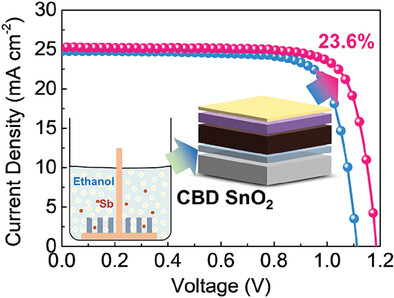
A method for high-throughput preparation of chemical bath deposited SnO2 has been developed through incorporating a concentrated tin source stabilized by the ethanol ligand, and doping with antimony. Consequently, the deposition time of SnO2 can be appreciably reduced from 3–4 h to only 5 min while maintaining 95% of the maximum efficiency when assembled in perovskite solar cells.
Highly Efficient MAPbI3-Based Quantum Dots Exhibiting Unusual Nonblinking Single Photon Emission at Room Temperature
- First Published: 10 December 2023
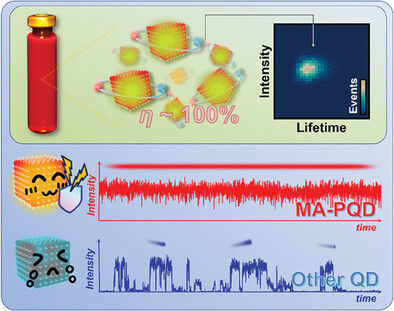
MAPbI3 perovskite quantum dots demonstrate remarkable robustness under electron irradiation and photon excitation. They exhibit a high near-infrared emission quantum yield of up to ≈100% and an unprecedented non-blinking single photon emission at room temperature. These characteristics promise unique potential in the fields of quantum information and bioimaging.
Single-Step Functionalization Strategy of Graphene Microtransistor Array with Chemically Modified Aptamers for Biosensing Applications
- First Published: 10 December 2023
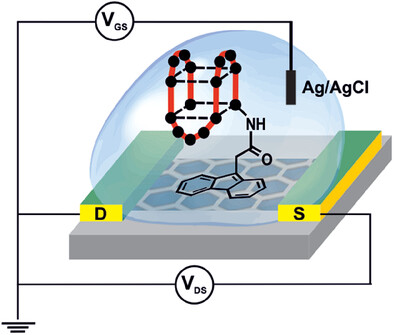
A novel strategy for direct biofunctionalization on graphene surfaces for biosensing applications based on single-step immobilization is presented. This efficient and faster approach is based on derivatized aptamers with fluorenylmethyl and acridine moieties and validated using arrays of 48 graphene SGFETs allowing multiple replicas. The presented straightforward functionalization is benchmarked versus standard multi-step strategy, offering a simpler alternative.
π-Sticked Metal‒Organic Monolayers for Single-Metal-Site Dependent CO2 Photoreduction and Hydrogen Evolution Reaction
- First Published: 01 December 2023
A Sharp Improvement of Sulfate's Birefringence Induced by the Synergistic Effect of Heteroleptic and Dimeric Strategies
- First Published: 10 December 2023
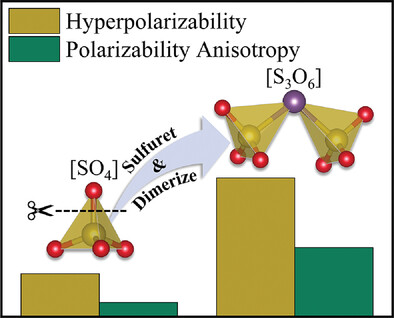
A novel strategy, the synergetic dimerization and heterozygosity of tetrahedra, is proposed and verified for enhancing the birefringence. Accordingly, polymorphic Na2S3O6 crystals with [S3O6] groups are obtained with a large birefringence in the monoclinic phase and a moderate second harmonic generation response in the orthorhombic one.
High-Stability RuNi/C Electrocatalyst for Efficient Hydrogen Oxidation Reaction in Alkaline Condition
- First Published: 06 December 2023
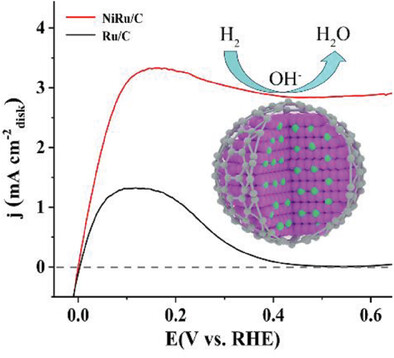
Carbon layer-coated NiRu alloy (NiRu/C) is synthesized to achieve the remarkable HOR activity in relatively high potential (2.93 mA cm−2disk at 0.6 V vs RHE). The electron redistribution in NiRu alloy improves the surface adsorption of reactants, and the outer carbon layer serves as electron conductor and protection layer. The composites synergistically achieve good performance.
Dielectric Regulation for Efficient Top-Emission Perovskite Light-Emitting Diodes with Suppressed Efficiency Roll-off
- First Published: 05 December 2023
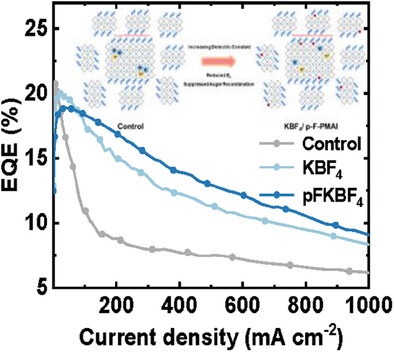
A dielectric regulation strategy is proposed to suppress the efficiency roll-off of perovskite light emitting diodes, by doping KBF4 molecules with large dipole moment to lower the exciton binding energy of perovskite. The optimal device delivers a maximum EQE > 20% and can retain EQE > 10% at J of 708 mA cm−2, efficient PeLEDs with ultra-low efficiency roll-off.
Fast Near-Infrared Photodetectors Based on Nontoxic and Solution-Processable AgBiS2
- First Published: 08 December 2023
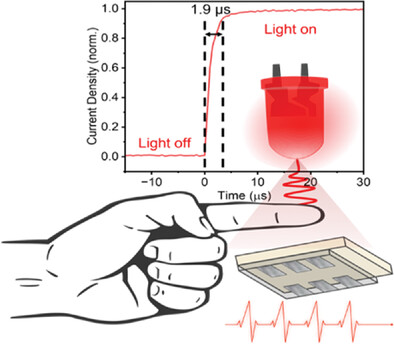
Fast near-infrared (NIR) photodetectors are vital for many applications, including optical communication and data transfer. Herein, solution-processed AgBiS2 photodetectors with a cut-off frequency approaching 500 kHz under NIR (940 nm) illumination, and >1 MHz under visible light are developed. The high response speed comes about because of the strong absorption of light in AgBiS2, enabling the fabrication of ultrathin photodetectors with fast charge-extraction, which is demonstrated as heart beat sensors operating in air.
MnF2 Surface Modulated Hollow Carbon Nanorods on Porous Carbon Nanofibers as Efficient Bi-Functional Oxygen Catalysis for Rechargeable Zinc–Air Batteries
- First Published: 06 December 2023
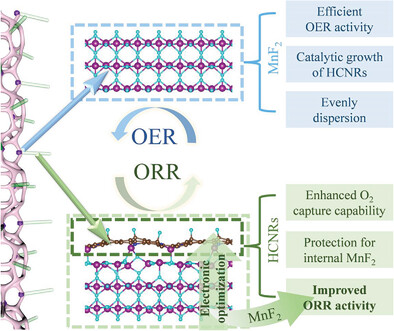
Manganese acetate allowed porous carbon nanofibers (PCNFs) to grow a large number of hollow carbon nanorods (HCNRs) and well dispersed MnF2 nanodots. MnF2 surface-modulated HCNRs can strongly enhance ORR activity, and the uniformly dispersed MnF2 can also provide higher OER activity. Thus, the prepared HCNRs/MnF2@PCNFs obtains efficient bifunctional oxygen catalytic ability and high performance rechargeable ZABs.
Interfacial Engineering of Fluorinated TiO2 Nanosheets with Abundant Oxygen Vacancies for Boosting the Hydrogen Storage Performance of MgH2
- First Published: 05 December 2023
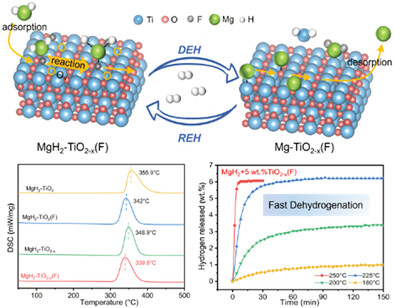
The interaction between the interface of fluorinated titanium dioxide with abundant oxygen vacancies (TiO2-x(F)) and MgH2 is investigated for the first time. During hydrogen ab/de-sorption cycles, the in situ generated MgF2 and MgF2-xHx can provide numerous nucleation centers for Mg/MgH2. Moreover, the synergistic effect between multivalent Ti species and oxygen vacancies can significantly accelerate the transportation of electrons.
Bioinspired Light-Driven Proton Pump: Engineering Band Alignment of WS2 with PEDOT:PSS and PDINN
- First Published: 03 December 2023
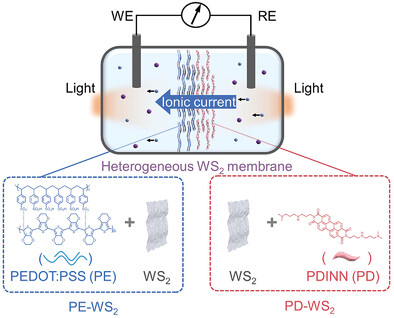
A heterogeneous tungsten disulfide (WS2) nanofluidic membrane by sequentially stacking PEDOT:PSS functionalized WS2 (PE-WS2) and PDINN-functionalized WS2 (PD-WS2) for light-driven active ion transport. The incorporation of organic materials promotes the photogenerated carriers separation of WS2 by engineering the staggered band alignment. The maximum output power can achieve 1.13 nW in equilibrium electrolyte solution.
Multifunctional Liquid Metal-Bridged Graphite Nanoplatelets/Aramid Nanofiber Film for Thermal Management
- First Published: 04 December 2023
Construction of Medusa-Like Adhesive Carbon Nanotube Array Induced by Deformation of Alumina Sheets
- First Published: 13 December 2023
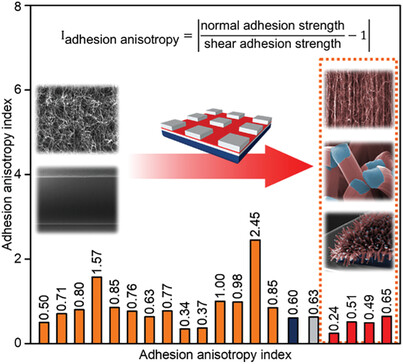
By depositing regularly arranged alumina sheets on the classical carbon nanotube array growth catalyst, and taking advantage of their thermal deformation to change their newly found ability to block the diffusion of the carbon source, this work obtains an adhesive nanotube array full of nanotube bundles on its upper surface, which exhibits a unique near-isotropic adhesion performance.
Platform for the Immobilizing of Ultrasmall Pd Clusters for Carbonylation: In Situ Self-Templating Fabrication of ZIF-8 on ZnO
- First Published: 10 December 2023

The zinc oxide (ZnO)-supported core–shell catalyst ZnO@MOF, with small apertures on the catalyst surface, provides a potential advantage for isolating metal-atom or metal-clusters sources as guests, which has a positive effect on the stability and activity of the catalyst. These results demonstrate the benefit of using core–shell ZnO@ZIF-8 as a platform for immobilizing ultrasmall Pd clusters for multiple carbonylation reactions.
Weak Ion-Exchange Based Magnetic Swarm for Targeted Drug Delivery and Chemotherapy
- First Published: 07 December 2023

In this work, a weak ion-exchange based swarm is presented that can self-organize and reconfigure by changing the frequency and strength of external magnetic field. Experiments show the high adaptability and functionality of the microrobot swarm in delivering drugs in confined spaces, which provides a new platform for biomedical and environmental applications.
Dendrite-Free Zinc Anodes Enabled by Exploring Polar-Face-Rich 2D ZnO Interfacial Layers for Rechargeable Zn-Ion Batteries
- First Published: 06 December 2023
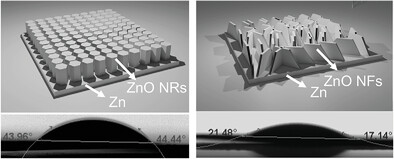
The desolvation of solvated Zn2+ ions is crucial for achieving dendrite-suppressive Zn anodes in high-performance aqueous zinc-ion batteries. The investigation of ZnO nanoflakes (NFs), which create artificial layers on Zn anodes, offers surfaces that are not only more polar than nanorods (NRs) morphologies but also enhance strong interactions with water molecules for exceptional hydrophilicity, facilitating the formation of ohmic contacts for efficient electron transport during Zn2+ plating/stripping processes.
Vacancy-Rich Bismuth-Based Nanosheets for Mitochondrial Destruction via CO Poisoning, Ca2+ Dyshomeostasis, and Oxidative Damage
- First Published: 06 December 2023
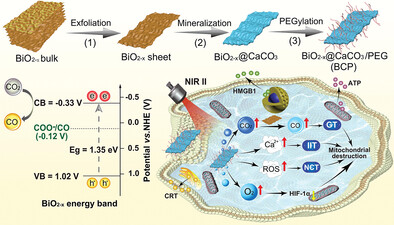
Vacancy-rich bismuth-based nanosheets of BCP are successfully developed for mitochondrial destruction via CO poisoning, Ca2+ dyshomeostasis, and oxidative damage. Upon endocytosis by tumor cells, lysosomal acidity causes the disintegration of CaCO3 nanoshell, followed by immediate Ca2+ release and CO2 production. Oxygen vacancies in BiO2-x lattice are preferable for CO2 absorption and efficient CO2-to-CO can be subsequently triggered by NIR irradiation.
A Spatially Controlled Proximity Split Tweezer Switch for Enhanced DNA Circuit Construction and Multifunctional Transduction
- First Published: 10 December 2023

A versatile spatially controlled proximity split tweezer (PST) switch for the transduction of diverse biomolecule into desired oligonucleotides is presented. Leveraging synergy between tweezer rigidity and hairpin lock can minimize DNA circuit leakage. The platform allows logical operations and direct coupling with DNA catalytic circuits. Its design simplicity, flexibility, and expandable complexity offer broad applications in research and biomedicine.
γ-Ray Irradiation Enables Annealing- and Light-Soaking-Free Solution Processable SnO2 Electron Transport Layer for Inverted Organic Solar Cells
- First Published: 06 December 2023

Annealing-free and light-soaking-free tin dioxide (SnO2) electron transport layers are developed and applied to non-fullerene organic solar cells (OSCs) based on PTB7-Th:IEICO-4F. The OSCs fabricated with pristine SnO2 exhibited 8.34% low efficiency without annealing. However, upon annealing the pristine SnO2 at 150 °C, the efficiency recovered to the normal value of 11.21%. The solar cell using γ-ray treated SnO2 demonstrated a comparable efficiency of 11.18% without any annealing process. Furthermore, the light-soaking effect disappeared in the γ-ray-treated SnO2.
Persistent Charging of CsPbBr3 Perovskite Nanocrystals Confined in Glass Matrix
- First Published: 06 December 2023
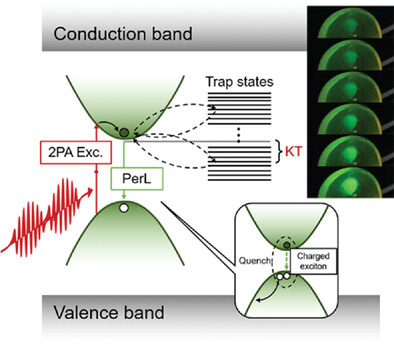
In this work, the two-photon persistent charging induced long-lasting afterglow and charged exciton formation are observed in CsPbBr3 nanocrystals confined in glass host. Combining the time-resolved transient absorption and temperature-dependent luminescence spectroscopy, the underlying mechanism involving two carrier-transfer channels is uncovered. On this basis, two different information storage devices are demonstrated, which pave a way towards novel information memory applications.
Prominent Structural Dependence of Quantum Capacitance Unraveled by Nitrogen-Doped Graphene Mesosponge
- First Published: 06 December 2023
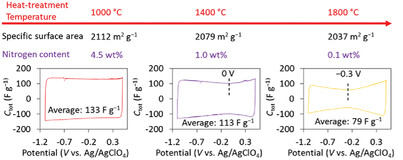
A series of nitrogen-doped graphene mesosponges with largely identical pore structures (≈ 2100 m2 g−1) but different heteroatom functionalities are developed. It is found that heteroatom functionalities determine total capacitance (Ctot), resulting in the cyclic voltammetry curves being rectangular or butterfly-shaped. The nitrogen functionalities are found to significantly enhance Ctot owing to increased quantum capacitance.
Mo2C-Based Ceramic Electrode with High Stability and Catalytic Activity for Hydrogen Evolution Reaction at High Current Density
- First Published: 06 December 2023

The electrode satisfies the requirements of green sustainability, economic viability, and largescale industrial hydrogen production. Under the high current density conditions, Mo2C-based ceramic electrodes with Mo2C (O)/MoO2 heterostructures present superior performance than commercial Pt wire electrodes. The prepared electrode can work stably at industrial-level current densities for more than 260 h, exhibiting excellent stability.
Cu Tailoring Pt Enables Branched-Structured Electrocatalysts with High Concave Surface Curvature Toward Efficient Methanol Oxidation
- First Published: 06 December 2023
Platelet Membrane-Derived Nanodiscs for Neutralization of Endogenous Autoantibodies and Exogenous Virulence Factors
- First Published: 03 December 2023
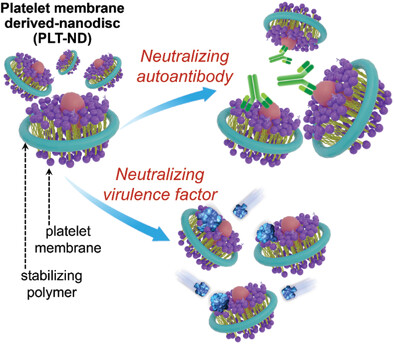
Platelet membrane-derived nanodiscs (PLT-NDs) are synthesized and evaluated for biological neutralization applications. PLT-NDs effectively neutralize anti-platelet autoantibodies and bacterial virulence factors both in vitro and in vivo. Treatments with PLT-NDs show significant therapeutic benefits in mouse models of immune thrombocytopenic purpura and methicillin-resistant Staphylococcus aureus infection, respectively.
Na2CeF6: A Highly Laser Damage-Tolerant Double Perovskite Type Ce(IV) Fluoride Exhibiting Strong Second-Harmonic Generation Effect
- First Published: 05 December 2023
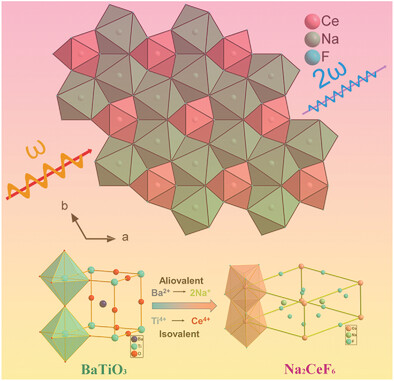
Here, an inorganic tetravalent cerium fluoride, Na2CeF6, is derived from the perovskite structure by double site cation substitution. It represents the first Ce(IV) fluoride nonlinear optical crystal and demonstrates a strong and phase-matchable second-harmonic generation effect (2.1 × KH2PO4). It also exhibits large laser-induced damage threshold (over 20 × AgGaS2).
Supermolecule Polymer Derived Porous Carbon Nitride Microspheres with Controllable Energy Band Structure for Photocatalytic Hydrogen Evolution Reaction
- First Published: 10 December 2023
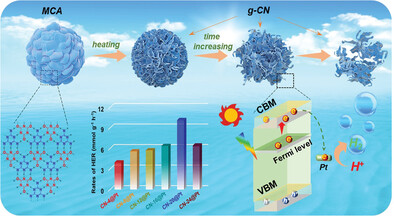
In this work, porous g-CN microspheres are synthesized via a simple method with MCA as the intermediates. And the morphology and energy band structure of g-CN are intimately calcination time-dependent. The visible-light HER rate of g-CN@Pt reaches 10.14 mmol g−1 h−1. The formation and internal mechanism of g-CN are studied and supplemented by theoretical calculations.
A 3D Cross-Linked Metal-Organic Framework (MOF)-Derived Polymer Electrolyte for Dendrite-Free Solid-State Lithium-Ion Batteries
- First Published: 14 December 2023
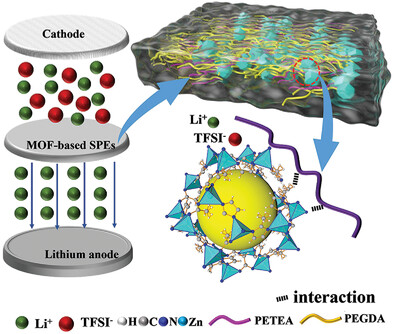
A novel 3D cross-linked metal-organic framework (MOF)-derived polymer solid electrolyte with good mechanical, ionic conductive properties, and interfacial compatibility is achieved by cross-linking vinyl-functionalized MOFs (Vinyl-ZIF-8) to polyethylene glycol diacrylate (PEGDA) through pentaerythritol tetraacrylate (PETEA). The unique structure of the MOFs-derived hybrids electrolytes adsorb anions and only allow Li+ to pass through, resulting in uniform Li+ flux distribution, high t+, and dendrite-free.
A Thermal-Ball-Valve Structure Separator for Highly Safe Lithium-Ion Batteries
- First Published: 10 December 2023

A high thermostable separator composed of PVDF and PEI is developed. The thermostable PEI microspheres are evenly dispersed in the PVDF film matrix which not only functions as a strong skeleton enabling the rare shrink of the separator at 200 oC but also acts as a ball valve shutting down the lithium-ion transmission channel at 150 oC.
Spontaneous Built-In Electric Field in C3N4-CoSe2 Modified Multifunctional Separator with Accelerating Sulfur Evolution Kinetics and Li Deposition for Lithium-Sulfur Batteries
- First Published: 06 December 2023
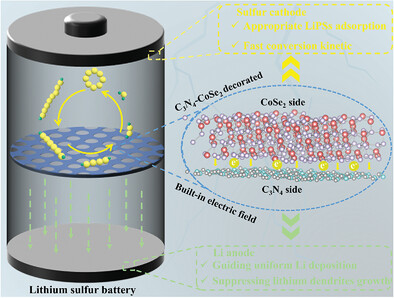
C3N4-CoSe2 composite are designed and used as lithium sulfur batteries (LSBs) separator. The moderate adsorption ability of C3N4-CoSe2 suppress the polysulfides shuttle effect. The formed internal electric field provided powerful kinetic for sulfur conversion reactions. The lithiophilic C3N4-CoSe2 help to regulate Li deposition, thus avoiding lithium dendrites. Consequently, the LSBs based on C3N4-CoSe2 functional separator display superior electrochemical performances.
Selective Detection of Functionalized Carbon Particles based on Polymer Semiconducting and Conducting Devices as Potential Particulate Matter Sensors
- First Published: 05 December 2023
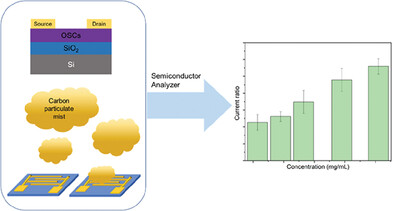
The paper illustrates a unique approach for detecting carbon particles, which have the potential to selectively detect particulate matter in aerosols. The sensing mechanisms behind the selectivity and sensitivity, and how to optimize the sensing responses and distinctions are also discussed. Polymer semiconductors can be promising materials for accurate and efficient particulate detection.
Highly Transparent, Yet Photoluminescent: 2D CdSe/CdS Nanoplatelet-Zeolitic Imidazolate Framework Composites Sensitive to Gas Adsorption
- First Published: 11 December 2023
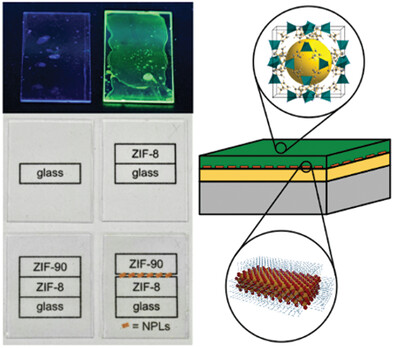
Thin composite films of zeolitic imidazolate frameworks (ZIFs) and colloidal 2D CdSe/CdS nanoplatelet (NPL) emitters with minimal scattering are formed by cycled growth and yield anti-reflective, yet photoluminescent coatings. The guest-host chemistry of the porous ZIF layer is used to change the photoluminescence of the NPL emitters by the adsorption of the guest molecules water and ethanol, providing an application toward innovative photoluminescence-based gas sensing.
SOx Functionalized NiOOH Nanosheets Embedded in Ni(OH)2 Microarray for High-Efficiency Seawater Oxidation
- First Published: 11 December 2023
Atomic Pyridinic Nitrogen as Highly Active Metal-Free Coordination Sites at the Biotic-Abiotic Interface for Bio-Electrochemical CO2 Reduction
- First Published: 06 December 2023
Metal-Organic Framework-Mediated Synergistic Hypoxia-Activated Chemo-Immunotherapy Induced by High Intensity Focused Ultrasound for Enhanced Cancer Theranostics
- First Published: 10 December 2023
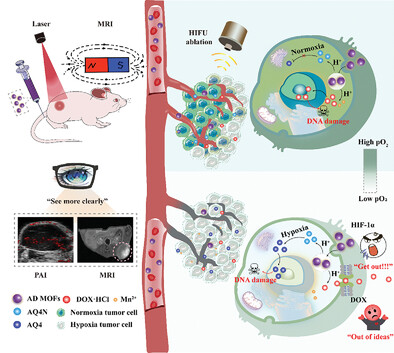
The HIFU-specific metal-organic framework nanosystem (ADMOFs) is constructed by coordinating AQ4N, Mn2+, and DOX. ADMOFs can efficiently enhance PA/MR imaging to more accurately guide HIFU surgery. Moreover, ADMOFs utilize the severe tumor hypoxic environment created by HIFU to conquer hypoxia-associated drug resistance and kill residual hypoxic/normoxic tumor cells. This strategy innovatively combines hypoxic-activated chemotherapy with HIFU to enhance cancer treatment.
Overcoming Low C2+ Yield in Acidic CO2 Electroreduction: Modulating Local Hydrophobicity for Enhanced Performance
- First Published: 10 December 2023
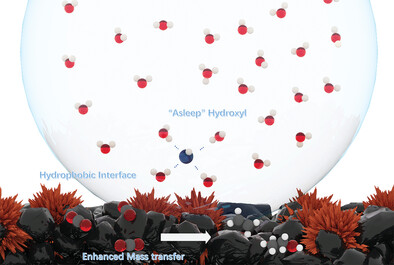
An in situ electrodeposition method is employed to modulate the catalyst coverage on the microporous layer, enabling a wide-ranging adjustment of the microenvironment hydrophobicity. Enhanced hydrophobicity significantly facilitates the yield of multi-carbon species and suppresses the parasitic hydrogen evolution. And the phenomenon can be further extended to an industrially relevant slurry-based approach with hydrophobic microspheres.
Tuning Proton Insertion Chemistry for Sustainable Aqueous Zinc-Ion Batteries
- First Published: 08 December 2023
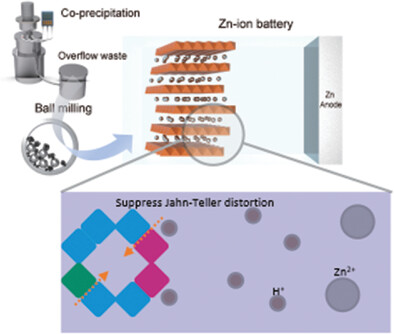
In the pursuit of sustainable energy solutions, the potential of manganese nickel cobalt dioxide materials for aqueous zinc-ion batteries are presented. By addressing the Jahn–Teller distortion through Ni and Co doping, the presented cathode material sheds light on achieving enhanced battery performance. These findings not only underline the importance of material engineering but also suggest a roadmap for eco-friendly battery solutions derived from wastewater processes.
Boosting Cu─In─Zn─S-based Quantum-Dot Light-Emitting Diodes Enabled by Engineering Cu─NiOx/PEDOT:PSS Bilayered Hole-Injection Layer
- First Published: 07 December 2023
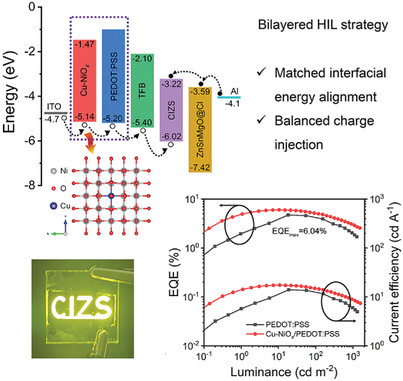
High-performance cadmium-free Cu─In─Zn─S(CIZS)-based quantum-dot light-emitting diodes (QLEDs) are achieved through tailoring interfacial energy level alignment and improving the balance of charge injection. The idea is to introduce a bilayered hole-injection layer (HIL) of Cu-doped NiOx (Cu─NiOx)/Poly(3,4-ethylenedioxythiophene):poly(styrene sulfonate) (PEDOT:PSS).
Centimeter-Sized Single Crystals of Tetrahedral Manganese (II) Halide Hybrids for Wide-Color Gamut Backlighting Displays
- First Published: 11 December 2023
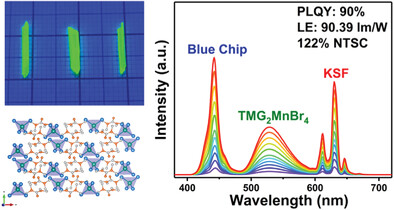
Two centimeter-sized manganese (II) halide single crystals TMG2MnCl4 and TMG2MnBr4 (TMG = 1,1,3,3-tetramethylguanidine) are synthesized, exhibiting bright narrow-band green emissions with high photoluminescent quantum efficiencies (PLQYs) up to 62% and 90%, respectively. The photoluminescence mechanisms are elaborated. Two white-light-emitting diodes for backlighting displays are fabricated, exhibiting the widest color gamut of 122% National Television Standards Committee (NTSC).
Chemically-Induced Lipoprotein Breakdown for Improved Extracellular Vesicle Purification
- First Published: 15 December 2023
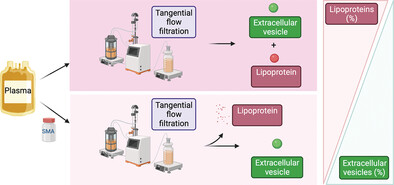
Removal of lipoprotein contaminants remains a major challenge for extracellular vesicle isolation from biofluids. This study describes the first extracellular vesicle purification method based on chemically-induced breakdown of lipoproteins. Samples are pre-treated with styrene-maleic acid prior to using conventional isolation methods as a simple and effective way to improve the purity and downstream applications of extracellular vesicles.
Manganese-Doped Bimetallic (Co,Ni)2P Integrated CoP in N,S Co−Doped Carbon: Unveiling a Compatible Hybrid Electrocatalyst for Overall Water Splitting
- First Published: 21 December 2023

The hybrid electrocatalyst (Mn−(Co,Ni)2P/CoP/(N,S)−C) develops through a hydrothermal and room-temperature aging method followed by chemical vapor deposition, exhibits outstanding performance in hydrogen and oxygen evolution reactions. The catalyst's effectiveness is attributed to abundant active sites, high porosity, and improved hetero-interface interaction among different phases, leading to a low cell voltage of 1.49 V@10 mA cm−2 and notable stability.
Enabling Internal Electric Field in Heterogeneous Nanosheets to Significantly Accelerate Alkaline Hydrogen Electrocatalysis
- First Published: 06 December 2023
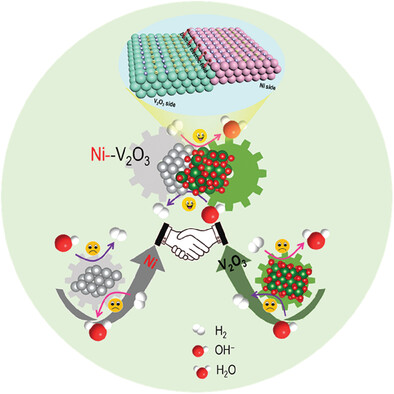
A robust internal electric field has been effectively engineered to induce an asymmetrical charge distribution on the Ni-V2O3 heterostructure, wherein the negative charge enriched V2O3 side facilitates the dissociation of water molecules, while the positively charged Ni side optimizes the H* adsorption, thus ensuring the excellent HER and HOR performance in alkaline electrolyte.
In Situ Interfacial Engineering of CeO2/Bi2WO6 Heterojunction with Improved Photodegradation of Tetracycline and Organic Dyes: Mechanism Insight and Toxicity Assessment
- First Published: 06 December 2023
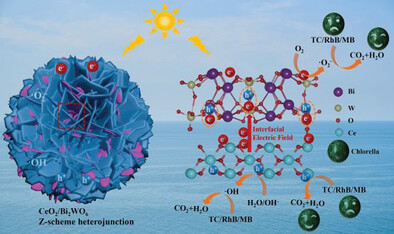
An exceptional Z-scheme CeO2/Bi2WO6 heterojunction photocatalyst is fabricated through a simple in situ liquid-phase approach. These as-prepared nanocomposites possess excellent photocatalytic properties for degrading tetracycline (TC), Rhodamine B (RhB), and methylene blue (MB). The toxicity of wastewater after photocatalytic treatment is significantly reduced, making it highly conducive to aquatic life and contributing significantly to environmental sustainability.
Synergy of Front-Surface Energy-Level Gradient and Lattice Anchoring Effect for Enhancing Perovskite Solar Cell Performance
- First Published: 07 December 2023
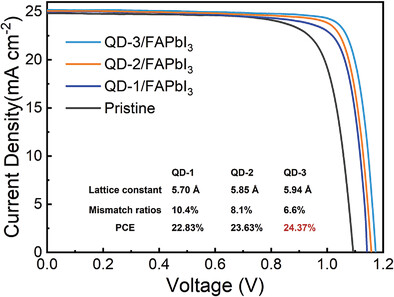
Constructing a front surface gradient, which increases minority carrier lifetime without defect passivation, is challenging for two-step processed perovskite solar cells. A front surface layer assembled of ZnCdSeS-based quantum dots enables a 73 mV gain in open-circuit voltage and a power conversion efficiency of 24.37% by forming a valance band gradient and minimizing the lattice mismatch with the absorber.
Silicon Nanowire Array Weaved by Carbon Chains for Stretchable Lithium-Ion Battery Anode
- First Published: 15 December 2023

A neat array of silicon nanowires is obtained by metal-assisted wet etching and lateral stripping. Silicon nanowire arrays combined with carbon nanomaterials of different forms and functions are used to construct a high-capacity stretchable flexible lithium-ion battery silicon anode. Good cycle life and magnification characteristics can be used to adapt to the next generation of wearable electronic devices.
Precursor Induced Assembly of Si Nanoparticles Encapsulated in Graphene/Carbon Matrices and the Influence of Al2O3 Coating on their Properties as Anode for Lithium-Ion Batteries
- First Published: 06 December 2023
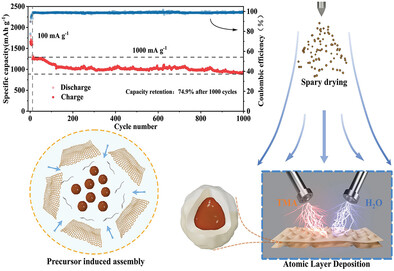
A porous composite of Si@rGO@C-SD-AlO has been fabricated by using a precursor induced assembly strategy and combined with the spray drying and an atomic layer deposition process. Protonated chitosan plays the dual roles of inducer for the assembly of graphene oxide sheets and the precursor for amorphous carbon. The composite can be used as a high-performance anode for lithium-ion batteries and it shows superior electrochemical performance, for example, excellent multiplicative performance (806 mAh g−1 at 5000 mA g−1), preferable initial Coulomb efficiency (up to 76.7%), high reversible capacity (1477 mAh g−1 after 500 cycles at 500 mA g−1), and excellent long-cycle cycling stability (930 mAh g−1 after 1000 cycles at 1000 mA g−1).
In-Plane Chemical Ordering (Mo2/3R1/3)2AlB2 (R = Tb, Dy, Ho, Er, Tm, and Lu) i-MAB Phases and their Two-Dimensional Derivatives (MBene): Synthesis, Structure, Magnetic, and Supercapacitor Performance
- First Published: 06 December 2023
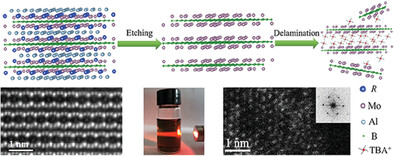
A family of hexagonal in-plane chemical ordering (Mo2/3R1/3)2AlB2 (R = Tb, Dy, Ho, Er, Tm, and Lu) i-MAB phases and their 2D derivatives MBenes are synthesized. The i-MAB phases with R = Tb to Tm are considered to be non-linear ferromagnetic. The pristine MBene@R exhibits poor supercapacitor performance, which, however, can be greatly enhanced by nitridation.
Mesoporous Nickel Sulfide Microsphere Encapsulated in Nitrogen, Sulfur Dual-Doped Carbon with Large Subsurface Region for Enhanced Sodium Storage
- First Published: 06 December 2023
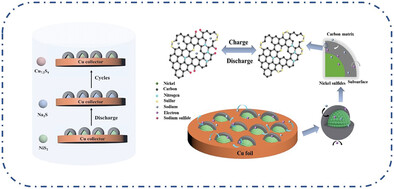
Mesoporous nickel sulfide microsphere encapsulated in nitrogen, sulfur dual-doped carbon (MNS@NSC) enhances the sodium storage because the superior pseudocapacitive capacity introduced by large subsurface of the particular packaged structure. Further, the formed Cu7.2S4 improves the conductivity and inhibits the polysulfide accumulation during the sodiation/desodiation process. Thus, a long-term stable MNS@NSC electrode in sodium-ion batteries has been realized.
Phase-Modulated Elastic Properties of 2D Magnetic FeTe: Hexagonal and Tetragonal Polymorphs
- First Published: 05 December 2023
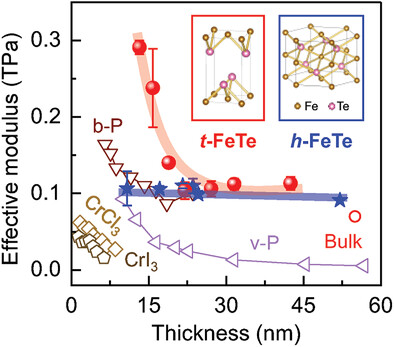
Phase engineering strategy is developed to efficiently modulate the elastic properties of 2D magnetic FeTe. It is found that the Young's modulus of 2D tetragonal FeTe shows the superior thickness-dependence to other known 2D materials, significantly different from that of hexagonal FeTe. The extracted modulus of tetragonal FeTe reaches 291 GPa when the thickness is 13.2 nm.
High-Performance Self-Powered Quantum Dot Infrared Photodetector with Azide Ion Solution Treated Electron Transport Layer
- First Published: 11 December 2023
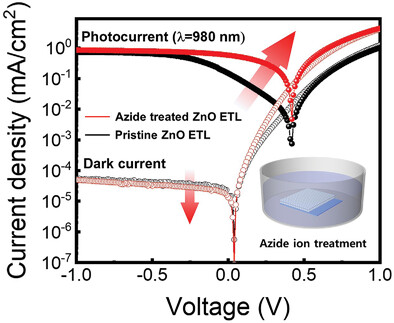
A high-performance quantum dot-based self-powered infrared photodetector is designed through azide ion solution treatment of the zinc oxide electron transport layer. Azide treatment effecitvely eliminated the traps at the interfaces between zinc oxide and lead sulfide quantum dot layers, improving the mobility of carriers and band alignment in the photodiode.
Hollow Core–Shell Bismuth Based Al-Doped Silica Materials for Powerful Co-Sequestration of Radioactive I2 and CH3I
- First Published: 07 December 2023
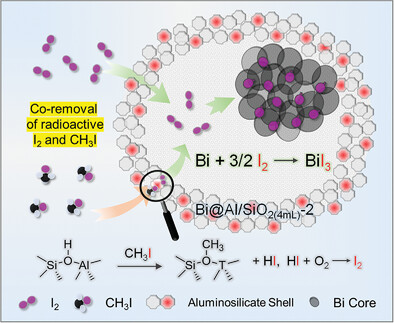
A series of hollow mesoporous core–shell bifunctional materials with adjustable shell thickness and Si/Al ratio are synthesized by cleverly designing sorbent structures. The introduction of BAS sites overcame the defect of conventional bismuth based functional materials (BBMs) not being able to adsorb CH3I, and achieve the co-removal of inorganic and organic iodine by BBMs for the first time.




